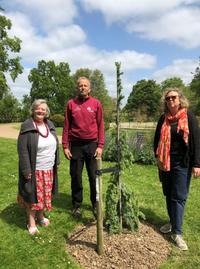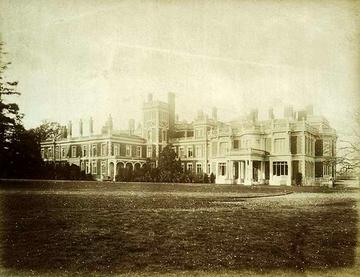Restored Italianate gardens tell the story of a now-demolished Jewish country house

(l to r) Elizabeth Stevens, Stephen Peters, Abigail Green
A cedar tree planted at the restored gardens of a former country house has been dedicated to the Jewish Country Houses project.
Worth Park, in Crawley, West Sussex was recently restored as a historic garden where a Jewish country house once stood. The house has been featured in the Jewish Country Houses project in Oxford University’s History Faculty, which aims to shed light on country houses in the UK and continental Europe which were owned, renewed and sometimes built by Jews, and those of Jewish origin.
Worth Park was purchased by Abraham Montefiore and his wife Henrietta (née Rothschild) in 1816. The property was expanded and went through several iterations before being rebuilt in the Italianate style in the 1880s. Successive generations of the Montefiore family lived here.

Worth Park, 1886 (Historic England)
The house became a school after the war, but it was demolished in 1968 and replaced by a block of council-owned flats. Its impressive gardens have been recreated thanks to funding from the Heritage Lottery Fund and Crawley Borough Council. Many of the features, the round fountain, Rockery, Islet in the lake and former stables have been given Grade II listed status. The Camelia walkway, part restored during the restoration, is unique in the UK. Stephen Peters, head gardener at Worth Park, has now planted 97 trees – including a Cedar tree dedicated to the Oxford project.
The Worth Park History Society has been studying the history of the site and works closely with the Jewish Country Houses project. The Worth Park History Society Costume Group were commissioned to make a copy of a dress for the Jewish Country Houses exhibition, which was inspired by the style of dress worn by Lady Louisa de Rothschild (née Montefiore) in the 1860s. It was displayed at Limmud Festival in December 2022 and at Crawley Museum in April-May 2023, where it was supplemented by local items loaned by the Worth Park History Society and Horsham Museum. The dress now forms part of the Worth Park History Society collection.
Professor Abigail Green, Professor of Modern European History in the Faculty of History and Director of the Jewish Country Houses project, said: “I have been hugely touched by this gesture. It is amazing to think that, in 150 years time, this tree will be as tall and gracious as the original Worth Park cedars. Sewing – a traditional handicraft – has given members of the Worth Park History Society an unusually deep connection with the lived experience of the past. All their work is imbued with a deep and creative empathy for the people who lived and worked here. As an academic historian, I find it very inspiring.”

The gardens at Worth Park today
Stephen Peters, Head Gardener at Worth Park, said: “it was indeed an honour to plant and dedicate this cedar tree to the Jewish Country Houses project, not only for all the work they have done over the years but also to establish a lasting connection between us and the fact it will be a living legacy for generations to come.” Elizabeth Steven, who founded the Worth Park History Society in 2018, said: “Cedar trees were chosen to be planted not only for their aesthetic quality and sustainability in today’s climate but also because of the Jewish symbolism that they hold in the Montefiore Coat of Arms.” The temple in Jerusalem was built from Cedar trees.
The Worth Park History Society has set up a museum in the Visitor Centre located in the Grade II listed former stables, which is open on Wednesday and Thursday afternoons – as well as other times by prior arrangement. The Society meets monthly, and a costume and craft group meets weekly. More information can be found https://www.facebook.com/WorthParkHistorySociety/ While Mr Peters has written in more detail about the garden restoration here.


